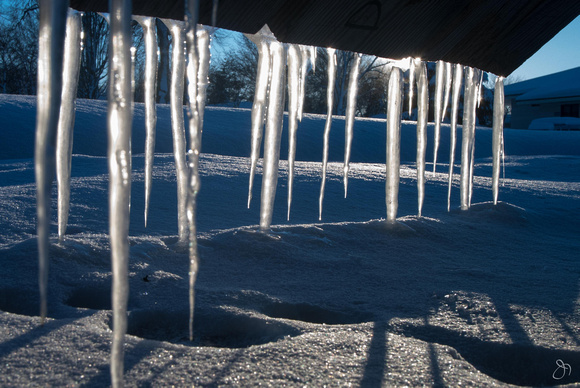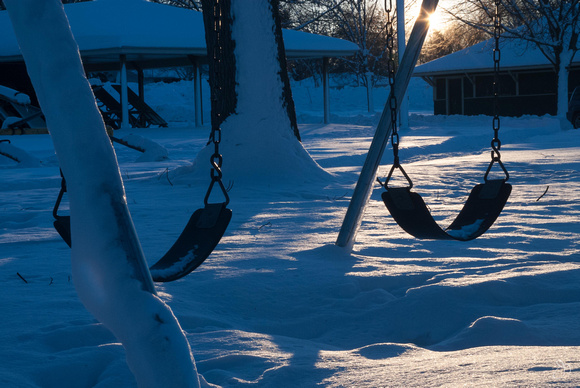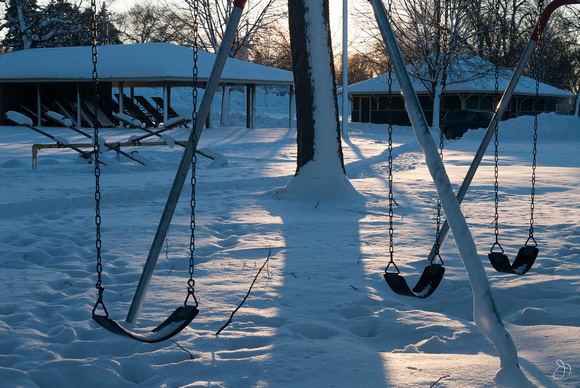Horicon Winter Snow, Ice and Texture Photography
Finally, the sun broke the overcast conditions we'd been having the past week here in Horicon, and I took the opportunity to go exploring some light out in the area. This time I landed at Discher Park next door.
 Ice Dance
Ice Dance
After scouting for images, I saw some icicles hanging off picnic tables that had been stacked for storage. They reached down about a foot from the end of the table to the ground. They were in a perfect position as the low light was filtering through from behind them. I knew that backlighting would provide a great texture and glow effect when exposed correctly. I knew it would be a nice, contrasty scene with texture and color.
That brings us to the exposure. How do you possibly capture this? Fairly easily. You put an incident light meter in the sunlight and point it at the sun to get your reading. I like incident metering because it meters the light itself. When you meter the light falling onto the scene instead of light reflected off of the scene, everything in that light falls into place tonally. The incident meter isn't fooled by highlights and shadows or even the bright sun. If you place the meter in the sunlight, the sunlight becomes the average, and everything in that light will fall into place. Everything in the shade will be darker, as it should be.
Pointing the meter at the sun also means you're protecting your highlights, which is important in digital. If you were to turn the meter away from the sun, the sensor would be cast in shadow, and the shadows would become the average light. Everything in the shaded areas would be exposed properly, but everything in the brighter light would be overexposed.
To see this at work in the image, look at the bright snow. That's the light in which I placed the meter. That meant everything under that light in the entire scene would be properly exposed (the highlights), and everything in the shadows would fall below that, as it should. This is a way of practicing what Ansel Adams referred to as "place and fall," placing one point in the image where you want it and observing where the other areas fall. Metering is much easier to understand hands on, so go out and try it.
Notice also that the background is smooth and not distracting. That was done on purpose. As you'll see in the study image below, other angles would've thrown too many elements into the scene.
To finish the image, I did some tuning in Lightroom, where I had complete control over color temperature, and then it went into CS6 for some Color Efex curves and a bit of contrast. Since I was lying on the ground, I could get away with no tripod, but to do that I had to bump the ISO to 400, the highest I will go for landscape. The texture of the snow makes it look like there's noise in the image, but upon close inspection there's little noise. That's in part due to RAW processing. Had I captured this in JPEG and then tried to manipulate it, there would've been damage to the information.
You can only get images like this if you look for light. What's interesting is how the icicles actually focus light down their shafts into the snow. Look for light before composition. Expose for the light and compose for interest.
Images for Study
 JAN_0063
JAN_0063
A quick look at the scene in backlight.
 JAN_0092
JAN_0092 Swings are still in the winter. Exposing for the light, composing for the interest. Notice that hiding the sun behind a pole prevents harsh glare and helps create a star effect, though you'd need a wider lens to achieve a true star.
Swings are still in the winter. Exposing for the light, composing for the interest. Notice that hiding the sun behind a pole prevents harsh glare and helps create a star effect, though you'd need a wider lens to achieve a true star.
 JAN_0083
JAN_0083 The sun is directly behind the tree. This enables me to capture the light without worrying about the sun blowing out part of the sky. The light illuminates, and the shadows provide depth and texture.
The sun is directly behind the tree. This enables me to capture the light without worrying about the sun blowing out part of the sky. The light illuminates, and the shadows provide depth and texture.
Comments
|
January
February
March
(4)
April (4)
(2)
May (2)
(2)
June (2)
July
August
(2)
September (2)
(1)
October (1)
(2)
November (2)
(4)
December (4)
|
(7)
January (7)
(5)
February (5)
(4)
March (4)
(3)
April (3)
(5)
May (5)
(4)
June (4)
(6)
July (6)
(9)
August (9)
(1)
September (1)
(1)
October (1)
(4)
November (4)
December
|
(3)
January (3)
(1)
February (1)
(1)
March (1)
(3)
April (3)
(1)
May (1)
June
(1)
July (1)
(3)
August (3)
(1)
September (1)
October
November
December
|
January
(1)
February (1)
(1)
March (1)
April
(1)
May (1)
(2)
June (2)
July
(6)
August (6)
(4)
September (4)
October
(3)
November (3)
(1)
December (1)
|
(2)
January (2)
(1)
February (1)
(1)
March (1)
(1)
April (1)
(1)
May (1)
June
(2)
July (2)
(1)
August (1)
(7)
September (7)
October
November
(1)
December (1)
|
(2)
January (2)
February
March
(1)
April (1)
May
(1)
June (1)
July
August
September
October
November
December
|
January
February
March
April
May
June
July
August
September
October
November
December
|
January
February
March
April
May
June
July
August
September
October
November
December
|
January
February
March
April
May
June
July
August
September
October
November
December
|
January
February
March
April
May
June
July
August
September
October
November
December
|
January
February
March
April
May
June
July
August
September
October
November
December
|
January
February
March
April
May
June
July
August
September
October
November
December
|

